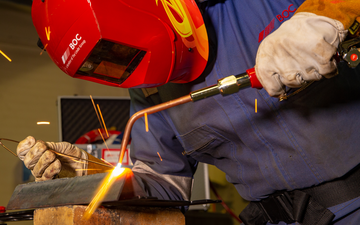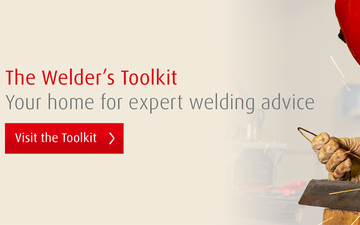- Official BOC UK Online | Industrial Gases | Products & Solutions | BOConline UK
-
Shop
- Industries
- Processes
- Gases & Equipment
-
Solutions
-
Services
-
Health & Safety
-
Contact & Support
- What's Happening
-
Net Zero Strategies
Seven Things to Consider when you’re Buying a Welding Helmet
Posted by BOC

If you’re wondering how to select the helmet that best fits your welding work, whether you need a replacement or you’re a first-time buyer, this guide will give you some pointers.
There are seven main aspects you should consider before investing in a new welding helmet. Let’s take a closer look.
1. What’s your welding task?
This might sound simple, but it will have a significant bearing on the type of helmet you need in terms of added features and, of course, cost. For example, welding in particularly tight or enclosed spaces will require a helmet with a Powered Air Purifying Respirator (PAPR) system – more of which later.
Then there’s the nature and frequency of your welding work. Professionals welding steel daily will need something more heavy-duty than the occasional welder who works with smaller, thinner pieces of metal. If the latter sounds like you, your main concern will be having a helmet that protects you from possible damage to your eyes caused by the arc, sparks and weld material spatter.
Our Gas & Gear team can discuss your welding set-up with you, including the equipment you’re using, to ensure you select a suitable helmet.
2. What’s your budget?
A huge range of helmets are now available for welding. As you might expect, the more sophisticated ones with many added features are at the top end of the price range.
It’s worth giving this serious consideration because, while a more basic version might not cost as much, added features and functionality can make a big difference to the quality and comfort of your weld.
BOC supplies a range of helmets to suit all needs, from low-cost versions to top-of-the-range units with all features. For example, our Ryval OHE410 welding helmet is a great option with the features you need at a low price. If you’re in any doubt speak to your local store to find out what’s best for you.
3. Do you need air purification?
As mentioned above, you have the option to buy a welding helmet with a PAPR system. Of course, a helmet without one will not protect the user from welding fumes. Understandably, because these feature sophisticated, battery-driven clean air technology, they are more expensive.
BOC’s PAPR system and welding helmet OHE450-PA700V2 offers the functions of BOC’s welding helmet with the protection of a PAPR system, so is a great choice if air purification is required.
While we always recommend using local fume extraction equipment (Local Exhaust Ventilation and Respiratory Protective Equipment) as the first line of defence when welding due to the potential carcinogenic fumes it produces, and there are certain circumstances when it’s a legal requirement, it’s really the responsibility of the welder based on their individual circumstances.
However, it is extremely important that you review the local rules. These can be found in full on the Health and Safety Executive’s website and in the HSE Publication WL3 Welding Fume Control. A correct risk assessment should always be carried out to ensure suitable products are selected for your welding environment and way of working*.
It’s worth noting, particularly if you want a safe weld, that all welding helmets on sale must conform to certain safety standards. The list is long. For example, BOC’s OHE575 welding helmet achieves the following standards and other certification besides: EN175, EB166, EN379, AS/NZS 1337 and 1338.
In addition, the government has introduced the UKCA ‘kitemark’ to replace the EU’s quality certification. If you’re unsure about the safety aspects of welding helmets, speak to our team.
4. Does the helmet offer enough shade?
Still on the subject of safety, finding the right level of shade is paramount when selecting a helmet. Broadly speaking, the higher the amperage needed for your welding task, the darker shade you’ll require due to a brighter arc – and vice versa.
Most helmets these days come with detailed instructions about shade range, and are fitted with controls to adjust the shade, instead of the welder having to manually change the helmet lens. Many helmets automatically adjust shade to suit the task at hand and filter harmful UV light.
The importance of shade cannot be overstated. Without it, you could be exposed to brightness you can’t tolerate – and that may lead to arc eye. This uncomfortable condition – also known as welder’s flash – flares up when ultraviolet radiation dries and inflames the eye, causing light sensitivity and a ‘gritty’ sensation in the eye. Though it is treatable, it’s definitely best avoided by using a helmet with the correct protective shades.
5. Is automatic sensitivity included?
When it comes to shade, for the most part, modern helmets include auto-darkening filters (ADF). Sensitivity is triggered by the level of brightness created during the weld. This is a bit like having reactolite (photochromic) sunglasses that become darker or lighter depending on the amount of light around you.
Sensitivity determines how much is light required in order to darken the welding filter - further protecting the welder’s eyes while offering enough visibility to get the welding task done, without the disruption of having to interrupt your activity to get the levels right.
Some helmets also feature a grind mode so that sensitivity won’t be triggered when you’re finishing off your weld.
6. How do you get the right fit?
It’s important to find a helmet that fits well and is comfortable, so having a fitting in-store is a good option.
The comfort of welding helmet materials has improved greatly in recent years, many now coming with strong but much lighter shells.
Meanwhile, magnifying lenses that can be switched in and out of the helmet are available so welders who normally wear glasses can avoid the hassle of taking them, and the helmet, on and off. Similar to a hard hat, most helmets now feature an adjustable cradle to fit your head snugly.
You should always try a helmet on before buying, and your local Gas & Gear store can guide you through the process to ensure that the fitting is right.
7. How big a viewing area do you need?
Visibility is as important as safety when you’re welding. The bigger the viewing area of your helmet, the less you’ll have to move your head, rather than just your eyes, to weld.
As an example, some helmets only include three-by-one inch viewing panels, but bigger ones are also available. These pricier options may also feature ‘true colour’ lenses that give the welder an untinted view of the weld.
Similarly, higher-end helmets are fitted with an adjustable visor for grinding work. This lifts up for better visibility but still includes a clear visor to protect the welder’s head and eyes during this work.
Once you’ve invested in and are using your welding helmet, remember to wipe it clean and store it sensibly after work. Also regularly check and change your lenses and filters.
Helmets are available at different price points and feature varying levels of sophistication. We hope this guide has provided insights into your main considerations, but don’t hesitate to drop into your local Gas & Gear store or chat to us online if you need further help. You can also visit BOC’s online shop to find the full range of welding helmets that we offer.
*BOC accepts no liability for the incorrect choice of RPE and LEV. A correct risk assessment should be carried out to ensure suitable products are selected for the environment and user. Details regarding performance and limitations of products are set out on the packaging and/or user instructions.

